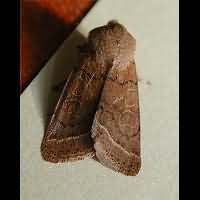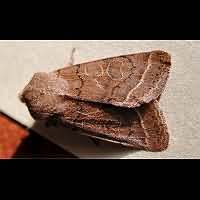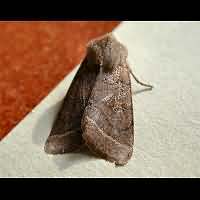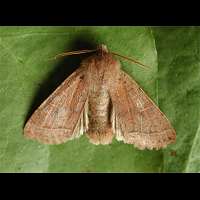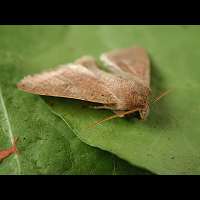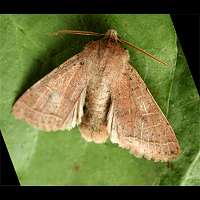Common Quaker Orthosia cerasi
It is best to identify the Common Quaker by looking at the following combination of characteristics. First both the kidney mark and the circular mark are rather big and with a thin white outline. In many cases this outline is the only thing you'll ever see, for the actual markings often have the same colour as the rest of the wing and are invisible. Secondly the tip of the wing is rounded. And finally the wavy line is light with dark edges and runs rather straight. The colour of the wing is no characteristic at all. It is extremely variable. For even though it is always a variation on the theme 'brown', it may be yellowish or ochreous brown, warm orange brown or cold greyish brown or even almost black. The wingspan of 34 to 40mm is typical for the size of a Quaker.
The eggs are deposited in small groups on or near growing buds and hatch after a few days. The small caterpillars live within the growing buds. Growing bigger they move to the outside of a shoot and spin together a few leaves. They rest between these leaves during the day and go eating other leaves during the night. Caterpillars in their last instar sit unprotected on top of a leaf or on the underside of the leaves of the foodplant. In summer they drop to the ground and spin a cocoon just beneath the surface. In this cocoon they pupate and then overwinter. The caterpillar is bright green with lots of whitish yellow speckles. It has a distinct white dorsal line and below that two much vaguer white lines on the sides. Characteristic is the yellow band around the 11th segment. The head is green. The caterpillar grows to a length of 35 to 40mm. It can be found on quite a number of deciduous trees, such as oak, birch and sallow.
The Common Quaker is on the wing at about the same time as other Orthosia-species: it flies about in March and April mainly. Flies by night only, but can be seen visiting illuminated flowers and catkins. They are easily attracted to both light and sugar. Specimens caught at night are easily photographed next day. They can even be manipulated. But be delicately, for once they get agitated, they will remain that way for a very long time. Very common all over England, Wales and southern Scotland. Less common in the rest of Scotland, the Hebrides and Ireland. Common over most of the European continent too.
It is best to identify the Common Quaker by looking at the following combination of characteristics. First both the kidney mark and the circular mark are rather big and with a thin white outline. In many cases this outline is the only thing you'll ever see, for the actual markings often have the same colour as the rest of the wing and are invisible. Secondly the tip of the wing is rounded. And finally the wavy line is light with dark edges and runs rather straight. The colour of the wing is no characteristic at all. It is extremely variable. For even though it is always a variation on the theme 'brown', it may be yellowish or ochreous brown, warm orange brown or cold greyish brown or even almost black. The wingspan of 34 to 40mm is typical for the size of a Quaker.
The eggs are deposited in small groups on or near growing buds and hatch after a few days. The small caterpillars live within the growing buds. Growing bigger they move to the outside of a shoot and spin together a few leaves. They rest between these leaves during the day and go eating other leaves during the night. Caterpillars in their last instar sit unprotected on top of a leaf or on the underside of the leaves of the foodplant. In summer they drop to the ground and spin a cocoon just beneath the surface. In this cocoon they pupate and then overwinter. The caterpillar is bright green with lots of whitish yellow speckles. It has a distinct white dorsal line and below that two much vaguer white lines on the sides. Characteristic is the yellow band around the 11th segment. The head is green. The caterpillar grows to a length of 35 to 40mm. It can be found on quite a number of deciduous trees, such as oak, birch and sallow.
The Common Quaker is on the wing at about the same time as other Orthosia-species: it flies about in March and April mainly. Flies by night only, but can be seen visiting illuminated flowers and catkins. They are easily attracted to both light and sugar. Specimens caught at night are easily photographed next day. They can even be manipulated. But be delicately, for once they get agitated, they will remain that way for a very long time. Very common all over England, Wales and southern Scotland. Less common in the rest of Scotland, the Hebrides and Ireland. Common over most of the European continent too.

